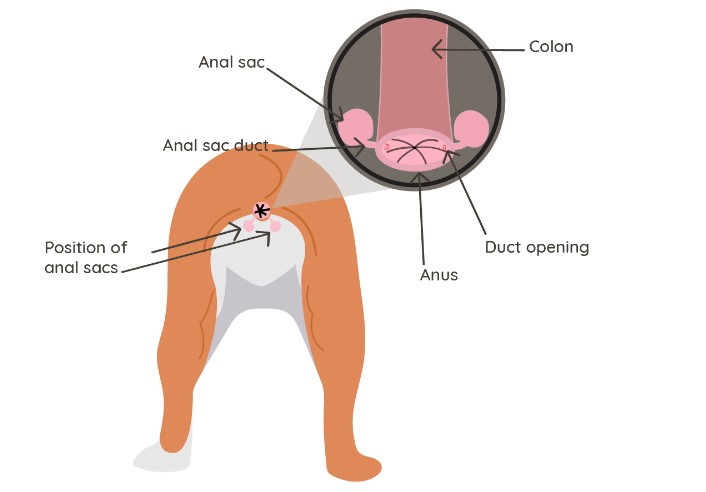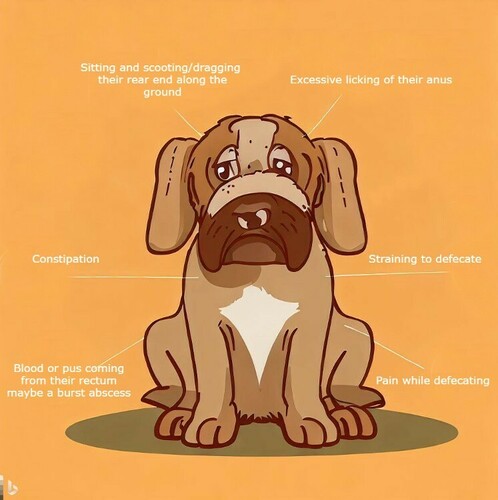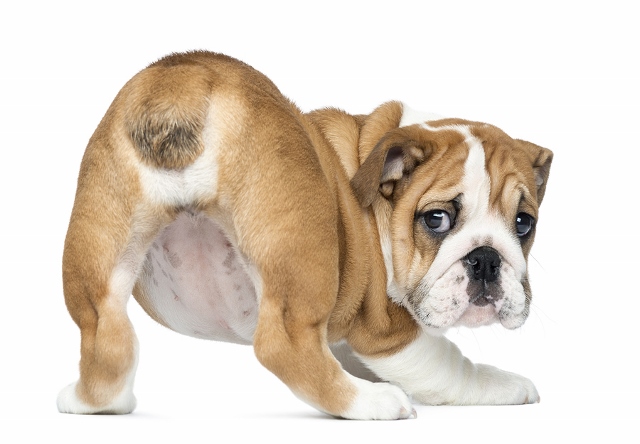Anal Glands in Dogs
As a pet owner, you might have heard about anal gland issues and how they can sometimes cause problems for your furry friend. Let's talk about what you need to know to keep your pet's anal glands healthy and comfortable.
Is your pet a bottom scooter?
Anal glands in dogs and cats can become irritated. If your dog is scooting their bottom along the ground, licking or cleaning down there regularly, it is a sign of irritation. Anal gland problems are primarily seen in dogs, but cats can also be affected. Sometimes you may not see your pet scooting across your carpet on its bottom, but you will certainly smell the fishy pungent odour – that's when our Anal GL remedy can help!
So, what are Anal Glands?
Your dog’s anal glands (or sacs) are two sacs located on either side of the anus, between the internal and external sphincter muscles. They have short ducts that secrete an oily brownish fluid with a powerful odour. The odour is a territorial marker and lubricant secreted each time the animal defecates.

When an animal has healthy anal glands and regular bowel movements, the sacs are emptied regularly and function properly. But if this is not the case, they can become full, and the contents thicken and become harder to pass, which is called impaction. Once the anal glands become impacted, they can become inflamed – leading to anal gland infections.
They may also develop an abscess that can burst through the skin lining, an excruciating problem for your pet. If you notice your dog scoots along the ground, they are doing this because they are itching the irritation. The scooting may help to release some of the fluid to give relief.
Causes of anal gland problems in dogs
Many things can cause blocked anal glands in dogs to become full, impacted, and abscessed:
- Diet – not enough fibre in their diet
- Wrong type or allergies to food
- Stools too soft (also a diet problem)
- Obesity
- Skin dermatitis/allergies
- Some dogs are just predisposed to this condition
Signs of blocked anal glands in dogs
Your dog or cat may not have all the symptoms below to have a blocked anal gland.
- Sitting and scooting/dragging their rear end along the ground
- Excessive licking of their anus
- Straining to defecate
- Constipation – not wanting to poo as it hurts
- Pain while defecating (they may cry out)
- Blood or pus coming from their rectum maybe a burst abscess

Often dog’s anal gland problems are misdiagnosed as being a worm infestation, which, if you haven't wormed your pets lately, is worth doing; you can use our Wiggles (Hom). It can also be a contact allergy to something like grasses, and you can look at our Spring (Hom) to help with that. But with worms and allergies ruled out, the main reason is usually an anal gland problem.
What can you do?
Knowing the signs and implementing a few things can significantly help your pet with anal gland problems.
- Diet is usually the top reason for anal gland problems, and feeding a raw diet is best. A diet high in bone content will make the stool firm, so the pet has to put the right amount of pressure into getting stool out. Therefore the glands are cleaned on the way. If your pet is not already on a raw diet, google raw feeding or raw meaty bones for ideas.
- Probiotics and Prebiotic supplements are excellent for the digestive system and firm the stool. Adding things like natural yoghurt, tripe (an organ full of good bacteria), kefir, kombucha, and human probiotics are all great sources you can add to their food.
- Regular exercise helps encourage bowel movements and keeps your pet healthy, and strong abdominal and butt muscles will help to put the right amount of pressure on the anal glands.
- Allergies can also be a factor, so treating environmental allergies such as grasses, wandering jew extra will reduce inflammation in the area. Check out our section to see what we have.
Natural solutions for anal gland issues
If you suspect your pet has anal gland problems, we’ve got natural anal gland supplements and solutions to help your furbaby.
Our Tagiwig range for cats and dogs has our Anal GL remedy, developed to help with irritated, inflamed, and infected anal glands. Many clients find this very helpful in assisting with this problem.
You can also make a calendula herbal poultice to help reduce inflammation.
Calendula Poultice Recipe
- Two tablespoons of dried calendula flowers
- 1 cup of boiling water
- Soak the calendula flowers in boiling water for 30 minutes
- When cooled to warm, wrap the herbs in a cloth, dip them into the fluid, and press them against your dog's anus. Repeat for 5-10 minutes
- Repeat every day until the glands are released and back to normal.
Contact us today!
If you have any other questions about your pet's anal gland problems, don't hesitate to contact us for a free chat. Or, if you want help with any other health problems for your pets or animals, you can book a consultation.
FAQs
What are the symptoms of blocked anal glands in dogs?
Symptoms of anal gland problems in dogs may include scooting, excessive licking or biting of the anal area, foul odour, and difficulty defecating.
How are anal gland problems in dogs treated?
Treatment for a dog"s anal glands may involve the manual expression of the glands, dietary changes, and the use of supplements or medications. In severe cases, surgery may be necessary.
Can dog’s anal gland problems be prevented?
While not all cases of anal gland problems in dogs can be prevented, maintaining a high-fibre diet and ensuring regular bowel movements can help reduce the risk. Keeping your dog"s anal area clean can also help prevent infection and inflammation of the glands.
Recent Articles

20% Off
All Cat Remedies
Lorem Ipsum is simply dummy text of the printing and typesetting industry. Lorem Ipsum has been the industry's standard dummy text ever since the 1500s, when an unknown printer took a galley of type and scrambled it to make a type specimen book. Lorem ipsum dolor sit amet, consectetur adipiscing elit. Vivamus leo ante, consectetur sit amet vulputate vel, dapibus sit amet lectus.



 Earn loyalty points everytime you shop
Earn loyalty points everytime you shop

